

|
| articles | forbidden stories I-State Lines resources my hidden history reviews | home | |

Writing/Film Don't Write for Readers, Just Write Grants Ernest Lehman, Screenwriter Central Casting, Dept. of Acceptable EVil Tinseltown Tags Titles from Bard When Empire Was Easy: Around the World in 80 Days American Identity Hapas: The New America Can You Tell What I am? Part I Can You Tell What I am? Part II Only in America Self-Reliance Unfolding Crises: Asia China: An Interim Report Shanghai Postcard 2004 Japan's Runaway Debt Train Will Avian Flu Trigger a Global Depression? China and India: Five Flies in the Ointment China & the U.S.: Circle of Self-Interest China Trade Surplus: Gusher Profits for U.S. Air Pollution and China's Future China: What a difference 27 years makes Battle for the Soul of America Katrina, Vietnam, Iraq: National Purpose, National Sacrifice The End of Empire is Real Simple A Degree of Success Why the Democrats Keep Losing American Chickenhawks: Your Congress Is This a Nation at War? A Nation in Denial Hawaii National Guard: An Unfair Deployment Planetary Meltdown Watch The Immensity of Global Warming Financial Meltdown Watch What This Country Needs Is a... Good Recession Are We Entering the Next Age of Turmoil? Housing Bubble? What Bubble? Housing Bubble II Housing Bubble III: Pop! Meltdown in the E.U. Meltdown: U.S. - China Retirees: the New Elite? Boomers: Prepare to Fall on Your Swords The Real Federal Deficit How much Is a Gallon of Gas Worth? The End of Cheap Oil The Word of the Decade: Gold The C.I.A., Oil and the Wisdom of Crowds Katrina's Long-Term Effects Catalyzing the Great Unraveling Welcome to 1935 Meltdown in the Making Is Risk Eliminated, or Merely Increased? Adios, O Bogus Prosperity The Flutter of a Butterfly's Wings? A One-Two Punch to a Glass Jaw Doubling Down on 5-Card No-See-Um Greenspan & The Conundrum Effect Why are we in this handbasket? Outside the Box How to Make a Favicon Asian Emoticons In Memoriam: Winky Cosmos The Wheeled Vagabonds In a Humorous Vein If Only Writers Had Uniforms Opening the Kimono One-Word Titles Complacency Nostalgia Praxis Keys to Affordable Housing U.S. Conservation & China Steve Toma, Me & Skil 77s: 30 years of Labor Real Science in the Bolivian Forest Deforestation and Sustainable Forestry Health, Wealth & Demographics Demographics and War The Healthiest Cold Cereal: Surprise! 900 Miles to the Gallon Are Our Cities Making Us Fat? One Serving of Deception Is Obesity an Inflammatory Response? Landscapes Terroir: France & California L.A.: It's About Cheap Oil The Last Redwood Airport Walkabouts Nourishment The French Village Bakery Ideas Understanding Globalization: Braudel Can You Create Creativity? Do Average People Know More Than Their Leaders? On The Impermanence of Work Flattening the Knowledge Curve: The "Googling" Effect Human Bandwidth and Knowledge Iraqi Guangxi History Bad Karma: Election Fraud 1960 Hiroshima: First Use Essential Books The Misbehavior of Markets Boiling Point (Global Warming) Our Stolen Future: How We Are Threatening Our Fertility, Intelligence and Survival How We Know What Isn't So The Coming Generational Storm: What You Need to Know about America's Economic Future The Third Chimpanzee: The Evolution and Future of the Human Animal Beyond Oil: The View from Hubbert's Peak The Party's Over: Oil, War and the Fate of Industrial Societies The Dollar Crisis: Causes, Consequences, Cures Running On Empty: How The Democratic and Republican Parties Are Bankrupting Our Future and What Americans Can Do About It More book reviews Archives: weblog September 2005 weblog August 2005 weblog July 2005 weblog June 2005 weblog May 2005 What's New, 2/03 - 5/05 |
Weblog and Wessays Welcome, readers, welcome. Please browse this month's weblogs and the wEssays listed in the sidebar. If you're in the mood for a short story, check out The Adventures of Daz and Alex: Stories of America. (They're all quick reads.) If nothing here strikes your fancy, skim through my recently published articles (generally in the San Francisco Chronicle) and my archives back to 1995. I would be honored if you linked any essay or story to your website, or printed a copy for your own use. And of course I appreciate your recommendations of this weblog and your comments: csmith@oftwominds.com. October 31, 2005 Stock Market Tea Leaves 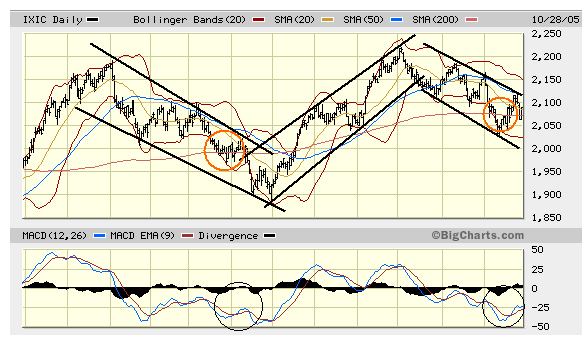
There are two schools of analysis in the stock market: fundamental, which looks at earnings and the prospects for higher profits, and technical, which examines historical charts and patterns for clues on the market's future direction. Here is a brief tutorial on technical analysis, using a chart of the Nasdaq from 10/28/05. It's been the contention of many, including myself, that the fundamentals of the nation's economy are shaky: that high energy costs, profligate borrowing and the housing bubble have laid the foundation for a recession which will take hold with jagged claws in 2006. On the other side of the ledger, analysts are touting the incredible growth of corporate profits--double-digit growth for 14 consecutive quarters! Don't you wish your paycheck went up 15%, quarter after quarter? How do they do that? They also contend housing is not in a bubble, and that unemployment is low, the GDP is rising and the consumer has lots of cash and borrowing power to fuel another 14 quarters of staggering corporate profit growth. Skeptics suggest that corporate profits wil someday have to slow, that much of that profit is accounting tricks, the GDP is growing only because inflation is rising, and that the housing bubble is topping as we speak, ending the main driver of this "recovery," "the house as a big ATM machine." So let's look at the charts. I've drawn what are known as channels in T.A. terms--lines which reflect the overall trend of the market. Currently the market is in a clear downtrend; optimists say it has just turned the corner and will start rising, just as it did in May of this year. T.A. folks say a trend changes when the market rises above or below the current channels. So far, there's no evidence the amrket has broken out of its downward trend. Entire bookshelves are filled with various charts and techniques for discerning patterns, and there are so many ways to chart the market that T.A. offers plenty of evidence for either a bull or bear argument. Still, it's worth looking at the MACD, which charts the "moving average convergence-divergence" as the lower set of lines. When the lines are below the zero line, note that the market declines; when they're above, the market is climbing. Note that the MACD is firmly entrenched in the lower territory. Another pattern chartists look for is the moving averages of the market, especially the 200-day moving average which is the thin red line on this graph. When the market is above its 200-day MA, it's on an uptrend; when it's below, it's in a downtrend. I've drawn red circles at the points where the market dropped down and hovered at its 200-day MA line. We are at such a point now. Will it drop below or shoot up in blissful euphoria? No one can say for certain, but the saying is, "the trend is your friend," and right now the trend is down. I don't have space here to mention the many other signs that all is not right in the stock market--an increasing number of new lows, a deteriorating Advance-Decline (A-D) line, or the fact that this bull market is historically long in tooth (most advances last about 30-36 months, and it's been 36 months since the last low in October 2002). The stock market historically makes its best bull moves in the period from November to May, so Wall Street is hungrily anticipating another year-end rally. (Oddly enough, no one seems to mention that the market's best run this year occurred precisely in the historically "slow" period, June through August.) If you look at the channels, it takes a wondrous crystal ball or a very blind faith to see a bull market in this chart. But only time will tell. October 29, 2005 All the Tea in China - All the Ginseng in America  As you can imagine, the ginseng was welcomed in China, and the trader made $30,000 profit from the year-long voyage, big bucks in those days. Others followed to such a degree that the market for ginseng fell due to oversupply. (Here's a link to a paper posted on columbia.edu.) Imagine that--the U.S. suppressing the price of ginseng in China due to its vast exports of the medicinal root. According to the fascinating little illustrated book All the Tea in China Trade between the U.S. and China, and the accompanying rising and falling fortunes of manufacturing and commodities, has a history stretching back to the very founding of America. October 28, 2005 Film Review: White (Part 2 of Trois Colours)  The three colors are inspired by the French flag and the high triad of values it represents: liberty, equality, and fraternity. Blue is said to express liberty, in the sense of Juliette Binoche freeing herself from grieving and loss. White is said to explore equality through the tortured emotions and power plays of a once-wed couple. The standard take on the movie is that it is an "ironic comedy," "a witty and sharp tragicomedy about revenge" or "a bleak comedy about inequality." Though I've seen the film before, I found no comedy to speak of but plentiful subtexts of love gone dark and the death and rebirth of one's identity. Interestingly, I have yet to find a review which pursues these themes. (If you haven't seen the film you might want to stop reading now, as I will discuss the ending.) The "equality" in a love relationship is explored on several levels in the film. The woman's name, Dominique, rather obviously introduces the theme of supremacy/dominance in a love match. This is reinforced in an early scene in which the woman (a waif-like Julie Delpy) throws her just-divorced husband out of his hair salon (now hers) after one last failed attempt at satisfactory sex. She says something along the lines of "I've won, I've won everything," by which she means the divorce and all his earthly posessions. There is also the firm suggestion that she's been dominant in bed, but without satisfaction. She also accuses Karol, her Polish ex-husband, of not understanding her love for him. You don't understand when I tell you I love you, or when I tell you I detest you, she exclaims in bitter exasperation. This introduces the dual nature of their bond--that the love each feels is capable of turning to rage, revenge and control--all the darker aspects of love which taste of obsession rather than true caring. Karol's friendship with a world-weary Pole injects another angle: that of death and identity. Without explanation, his new friend asks Karol to kill him. He eventually concurs, but with a twist: he first fires a blank shot, and then asks if his friend is still sure he wants to die. His friend changes his mind and decides to live. In a parallel fashion, Karol also decides to live. Rising from a real bottom (rejected by his wife, robbed and beaten, penniless except for a two-franc coin), he engineers a stunning turnaround by becoming a wealthy businessman-- and not always with entirely pure-white ethics. His motivation, we learn, is also not pure. He has built his fortune in order to entice his ex-wife to Poland. Toward this end, he wills his fortune to her and fakes his own death. After she has dutifully arrived for his funeral, he watches from a distance in a classic "watching your own funeral" shot, and witnesses her crying at his grave. Thus he learns that she does love him, and he appears in her hotel bed to finally satisfy her physically. His sexual potency is a not-too-subtle analogy of his emergence from being a dominated loser into a take-charge character. In a final twist, he manipulates his ex-wife into jail for supposedly murdering him; her protests that he is alive die in her throat, and we next see her behind the screened window of a prison. We learn that he was supposed to flee to Hong Kong to start a new life; instead, we see him enter the prison as a visitor, bearing gifts for his ex-wife. From the window, she makes a very ambiguous series of hand signs to him, including one which is unmistakably the act of sliding a wedding band on her third finger. As he watches her, tears roll down his cheeks. It is an artfully enigmatic ending. Are the tears of sadness for what he has done to her, or of victory that now he has exacted revenge, or of heartache for what both have lost? It seems to me that each person's love darkened in turn; for his inability to satisfy her sexually, she punished him most uncharitably; and when he realized he had truly lost her, then he baited her with a fortune and drove her first to bed and then to imprisonment. The prison, it seems, is not just walls around her; for he is imprisoned, too, by his continued ties to her. He cannot escape to Hong Kong and a new life; in that sense, his life is as forfeit as hers. His rebirth as a strong character has been wasted on punishing her, and now he too has nothing except his sad visits to the woman who once dominated him. Her emotions are equally enigmatic; is she signing that she still loves him? But who would trust the expressions of an wrongfully imprisoned woman? Is this the kind of love he has sought, that of dominance rather than caring? These are disturbing images and themes, for we see just this sort of violent struggle for control at play every day in domestic abuse. The film is a success in terms of being thought-provoking, but it has a contrived feel which detracts from the experience. How Karol convinced the Police to assume she murdered him is left unclear, as is her motivation for turning from a loving bride to a cruel witch. It seems that ultimately it is a movie constructed less around characters than around the interplay of powerful themes, and while that has its own rewards, it also has its own costs. October 27, 2005 Read This Book: The Solar Economy  For oil, that includes the cost (including the environmental damage) of getting it out of the ground, of transporting it to a refinery, of refining it, of transporting it to the customer and the cost to the planet's atmosphere and human health (basically beyond measure) of burning hydrocarbons on such a vast scale. Nuclear energy has a similarly costly series of steps, plus the additional risks of storing the radioactive waste and running breeder reactors (those that produce weapons-grade plutonium as part of their production cycle). Solar energy, in contrast, has a very simple cycle of costs: manufacturing the panels, transporting them to the installation site, and that's it--solar has no costs beyond minor maintenance for several decades after the initial manufacture and installation. Furthermore, the infrastructure for delivering that power is already built (the electrical grid). As for solar being impractical, Scheer shows that simply covering 40% of the existing roofs would generate much of the power required by developing countries, even accounting for bad weather and the challenges of storing power for nighttime useage and cloudy weather. Obviously, there are energy uses which cannot be met directly by solar-generated electricity, such as air transportation; but the point is that the vast amount of fossil fuels currently being burned to generate electricity and heat water could be replaced by solar, thus conserving increasingly costly petroleum for air transport. After reading the book, you have to ask yourself if "it can't be done" is practical skepticism or a bias carefully nurtured by what amounts to propaganda. October 26, 2005 Whither Oil? 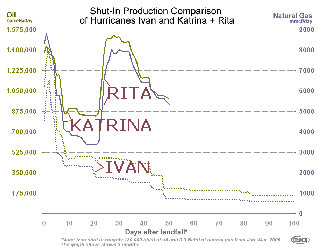 As you've no doubt noticed, oil and gasoline have dropped in price recently. But will it last? The
answer lies in this chart. These lines display how much oil and natural gas production is still off-line
(called "shut-in" in oil-industry lingo) as a result of Katrina and Rita, compared to the effects of Huricane
Ivan in 2004.
As you've no doubt noticed, oil and gasoline have dropped in price recently. But will it last? The
answer lies in this chart. These lines display how much oil and natural gas production is still off-line
(called "shut-in" in oil-industry lingo) as a result of Katrina and Rita, compared to the effects of Huricane
Ivan in 2004.
The numbers on each vertical axis indicate how much production is still sealed off; the higher the lines, the greater the amount of oil and natural gas which remains out of production. The horizontal axis indicates time. So we can see that Ivan's toll on production was severe but short-lived; within ten days or so, only a small percentage of production was still shut-in. In contrast, Katrina and Rita wreaked such havoc on the region's pipelines and other infrastructure that almost a million barrels of oil a day and over 5 million cubic feet natural gas are still out of production--and look to remain out of production for some time. The U.S., Japan and the European Union released 60 million barrels of oil and oil products from their strategic reserves after Rita and Katrina, but the effects of that one-time flooding of the market will soon wear off. (Recall that the U.S. consumes 23 million barrels of oil a day.) And when it does, then the shortages inflicted by the loss of production in the Gulf will rear their ugly heads yet again. To quote a recent news item in the Wall Street Journal: In a sign that the recent stability in oil markets may be a temporary lull, the International Energy Agency's executive director Friday warned that petroleum supplies may start tightening again as early as next month.In other words, enjoy the cheaper gasoline while you can; it won't last. And get out those wool sweaters, because natural gas isn't going down in price, either. October 25, 2005 The Scandals Yet To Come One of my correspondents has long pondered the insidious consequences of the shady, lightly regulated dealings of our "market economy": derivatives, "naked shorting" (the practise of selling shares in a company you don't even own to manipulate the price down) and the five-card Monte known as "accounting" in cases such as Enron. Her comments on the recent implosion of Refco may well be precient: Last week, about 30 big investors and bankers held an unusual two-hour conference call to figure out what to do about Refco, which besides commodities also handles exchange-listed stocks, currencies and private trades of the "complex financial instruments known as derivatives". Its customers are chiefly financial institutions as well as some sophisticated individual investors.Where indeed? The immense fraud perpetrated within the obscured spinning wheels of Refco should sow some healthy skepticism about the potential for other hedge fund unravelings. But the markets barely took notice of the salient points of the Refco case: huge frauds are still going undetected until the damage has already been wreaked, and the amount of precariously leveraged derivatives such hedge funds control is completely unknown. The Refco unraveling suggests that the risk of a cascading series of implosions which could precipitate a full-blown financial panic (a la the 1997 "Asian Contagion" or the 1998 Long Term Capital Management meltdown) is increasing. Yet the press and the markets scarcely noted the danger signs being flashed as Refco unraveled. Is such ignorance bliss? History suggests that willfully ignoring the risks created by heavily intertwined, massively leveraged derivatives lays the foundation for a "great unwinding" of all such financial instruments. October 24, 2005 The Great Karmic Unraveling "The divine wrath is slow indeed in vengeance, but it makes up for its tardiness by the severity of the punishment." As a non-partisan voter, I note without any partisan schadenfreude that second terms are not kind to U.S. presidents. Those few who've earned another four years (Reagan and Clinton) have seen their ships of state run aground on the shoals of over-reach or scandal: the absurd entanglements of the Iran-Contra Affair for Reagan and the Monica farce for Clinton. Both were entirely needless; if Reagan wanted to bypass Congressional spending limits to fund the Contras, he could have called upon all his wealthy pals rather than embroil the nation in a tawdry (and illegal) scheme involving the loathesome Iranian regime. As for Clinton, if he couldn't keep his zipper up, then he could have had the good sense and strength of character to admit it openly and show some contrition rather than grimly stonewall the consequences of his adolescent insecurities. Now we are witnessing what can only be described as the Great Karmic Unraveling of the Bush Administration. Chief aides of both the President and Vice-President may be indicted this week, and with good reason: imagine their outrage had it been a Democrat who exposed a C.I.A. agent and her husband to possible targeting by the nation's enemies. Clearly, someone leaked Plame's identity to the press, and they should go to jail for that. If someone tries to mislead the investigation or lie about their role, then they too should spend time in the Federal Pen. Then there's the war in Iraq, which is obviously going badly because Bush and his team rushed to war without adequate planning for the aftermath. Expertise was available for such planning, but the ideologues would have nothing to do with mere expertise. There are any number of sources confirming this appalling lack of planning; check out this one in the L.A. Times ( free online registration required; it's worth it). Then there's the great unraveling of an economy utterly dependent on a spendthrift Federal government and consumer, voraciously borrowing 80% of the entire planet's savings each and every year just to sustain the debt monster which is the U.S. economy. With debt spiraling into the trillions and the current account deficit exploding to $800 billion per year, this is the very picture of unsustainable debt and trade imbalances. It's worth repeating: "The divine wrath is slow indeed in vengeance, but it makes up for its tardiness by the severity of the punishment." October 22, 2005 A Busy Month  It seems we've covered a lot of ground this month, and just in case you missed a post or two,
here's the list of topics covered. Just scroll down this page to view all posts.
It seems we've covered a lot of ground this month, and just in case you missed a post or two,
here's the list of topics covered. Just scroll down this page to view all posts.
To lighten up the occasional doom-and-gloom report (Social Security bankruptcy, dollar poised for decline, etc.) I'm posting three photos from my September visit to Smith Mountain Lake in Virginia.  The photos document an activity called "tubing," in which the participant straddles a large inner tube
covered with durable fabric. Said large tube is then pulled behind a boat speeding along at 30+ miles
per hour, and said boat is driven with wild abandon in the hopes the rider flips over and is dislodged
from the tube, triggering a dramatic tumbling crash.
The photos document an activity called "tubing," in which the participant straddles a large inner tube
covered with durable fabric. Said large tube is then pulled behind a boat speeding along at 30+ miles
per hour, and said boat is driven with wild abandon in the hopes the rider flips over and is dislodged
from the tube, triggering a dramatic tumbling crash.
 My friend Ashton Erler and his good pals Maria and Jamie invited me to join them, and
it was indeed the ride of a lifetime--especially when the "captain" of the boat has been reduced to one
useable arm (note the sling on Ashton). The snapshots are courtesy of Maria, who survived her wild ride
with admirable aplomb.
My friend Ashton Erler and his good pals Maria and Jamie invited me to join them, and
it was indeed the ride of a lifetime--especially when the "captain" of the boat has been reduced to one
useable arm (note the sling on Ashton). The snapshots are courtesy of Maria, who survived her wild ride
with admirable aplomb.
 I found truth in Jamie's dictim, "You're not having fun unless you're
bleeding," as the constant bouncing off the wakes rubs your elbows raw as you flail against the harsh
nylon fabric covering the tube. It's also a good way to dislocate a shoulder, but we all avoided serious
injury, and an excellent time was had by all.
I found truth in Jamie's dictim, "You're not having fun unless you're
bleeding," as the constant bouncing off the wakes rubs your elbows raw as you flail against the harsh
nylon fabric covering the tube. It's also a good way to dislocate a shoulder, but we all avoided serious
injury, and an excellent time was had by all.
October 21, 2005 Of Splogs, Blogs, Aggregators and "News" Alas, spamming has moved with a vengence to the blogosphere, earning the ugly moniker splog. The most interesting features of blogs--their openness to reader comments, and the transparency of those "threads" (strings of comments on a single topic)--are precisely what is being exploited by splogging, which posts spam messages as reader comments. The other innovative trait of blogs--their ease of use--is also being exploited, as sploggers fabricate fake blogs by the millions in order to push some product or service. This of course makes the job of the new Yahoo and Google "blog search" services much more difficult, as there is so much chaff (splog) spontaneously appearing amidst the wheat. (It's also why I rely on plain old email for reader comments.) Another noteworthy innovation gaining steam is aggregators: websites or toolbars which allow the user to collect or aggregate a variety of news sources--including blogs like this one--into one customized window using the RSS (Rich Site Summary) XML-based (Extensible Markup Language) technology. Awfully nifty, but is there any software which can sort "news" from slapped-together opinion or plain propaganda? No. That's what you pay an editor for. In other words, you can aggregate all the garbage "news" you want and you still have garbage. This ties in with the apparent belief of the under-30-crowd that "news" is free, or should be free. The only problem is: gathering data, analyzing it, interviewing sources, fact-checking and editing are not free. As a free-lance journalist, I can tell you that the standards of major print media (newspapers and magazines) are very high. It takes a minimum of a solid week to assemble a thorough story, and much longer if it's an investigative piece which explores information that someone in power wants to keep hidden from public view. For an example of my own non-investigative work, check this story on wine-country water-use issues that was published in the San Francisco Chronicle Magazine. So what is offered for "free" on major newspaper sites isn't free--it's just the print media's desperate attempt to not lose readers to the Web. On the other hand, the Wall Street Journal has hundreds of thousands of online subscribers (such as myself) because the quality of their reporting is well worth the $79 a year. Two people attending just about any major-market sports event in the country blow more than that for 1) a crappy game 2) a crappy seat 3) a crappy overpriced beer 4) a hideous commute amidst an ugly crowd. So if a single lousy game costs more than a year of quality news, then why should news be free? As the saying goes, you get what you pay for, "news" included. There is an even more insidious consequence of "free news" slapped together off wire services and opinion-blogs passing as "news": the loss of actual investigative reporting. "Free news" necessarily takes officials at their word, because there's no infrastructure and money to pay for a skeptical analysis. So the degradation of actual news to "free news" threatens not just the old media but truth itself. If I am in a position of authority and power, either governmental or private, I am absolutely thrilled with "free news" because that means no one has any time to go digging around my hedge fund or my "official" business of influence-peddling and subversion of the public interest. The loss of real news--real reporting, real editing, real skepticism--would be catastrophic to the Republic. This is why the vast majority of links I post here refer you to legitimate print sources (which I happen to subscribe to): the S.F. Chronicle (of course), the Wall Street Journal, The Economist, BusinessWeek, Scientific American, Foreign Affairs and the New Republic, to name a few. I also post academic resources, as they must withstand the critique of peer review. This is standard journalism: the sources are transparent and reputable. That's the foundation of news. October 20, 2005 A Rickety Global House of Cards If you want to understand the risks of a dollar/bond collapse and ensuing global depression, I recommend getting a copy of the Wall Street Journal's October 19 edition and reading Econoblog: Global Balancing Act. (Online subscription required, but you can always read it at your local library for free.) There's a lot of heavy-lifting going on in this exchange between two very knowledgeable real-world economists, but I'll try to summarize the basic dynamic. Developing Asian countries, particularly China, have a surplus of labor, and a political need to put all these people to work. Hoping to be like Japan in another decade, they seek growth through exports. Every other Asian government has the same model, so there's fierce competition to find consumers for all the goods being made. While Asian economies are growing, it isn't consumer spending which is growing so much as exports and investment. So who's buying all the stuff Asia makes? The West, of course. Alas, the European Union nations all depend on exports for growth, too, except for Britain, and so their consumer sectors are languishing as well. Who's left? The redoubtable American consumer. OK, so how can China encourage the American consumer to buy its output and keep its workers employed? Well, it can keep the yuan cheap versus the dollar, so Chinese goods remain cheap, and it can keep U.S. interest rates low so Americans can readily borrow money to keep buying more stuff. How does China do this? By buying American Treasury bonds. Like everything else, currencies and bonds are ruled by supply and demand: lots of supply and no demand, the price drops. So if China started selling dollars, the dollar would drop, and if they didn't keep buying bonds, the interest rate would rise until enough buyers were tempted to invest in U.S. Treasury debt. So far so good, but the imbalances in the system are growing. Asian and E.U. consumer spending has been weak for years, and so the entire world is counting on the U.S. consumer. To keep propping up U.S. consumer spending, China and other exporters (of goods or oil) have been pouring basically their entire nations' savings into U.S. bonds. To quote from the article: "Reserve accumulation by the (exporting nations) went from $116 billion in 2001 to $517 billion in 2004 and maybe $600 billion this year, while the U.S. current-account (trade) deficit went from $390 billion to $800 billion." In other words, as the U.S. trade deficit grows to unprecedented levels, the exporting nations are "in for a nickel, in for a dime"--they have no choice but to keep funneling hundreds of billions of dollars into U.S. bonds to keep U.S. interest rates cheap, enabling U.S. consumers to buy more of their goods. But the entire edifice is a house of cards; as the imbalances increase, a variety of other distortions appear. You might think that all these cheap interest rates would have sparked an investment boom in the U.S. Exactly the opposite has occurred: U.S. corporations are hoarding their cash like no tommorrow, amassing unpredented cash reserves of over a $1 trillion. If they were so sure that global growth was going to be great, then why aren't they investing in new plants and R&D? Obviously, they aren't so optimistic. So where has all this unprecedented flow of foreign money into the U.S. ended up? In real estate, which has experienced an unprecedented bubble valuation. All the savings of Asia and oil-exporting nations have flowed into what is the ultimate non-productive asset: U.S. housing. Even worse, it's the Chinese taxpayers who are bearing the burden; the Central Government could be using all their savings to fund a social security system or other benefits for the Chinese citizenry. Instead, it buys and holds dollars and U.S. bonds paying a lousy 4%-- a low-return form of "dead money" if there ever was one. The key take-away here is that some 80% of the entire world's savings is flowing into the insatiable maw of U.S. debt in order to keep U.S. interest rates low and the dollar stable. There are alternatives; Asian governments could give up the export-growth model and start boosting their homegrown consumption. But the export model has worked so spectacularly to date that they cling desperately to it, no matter what the cost. But what happens when their key market, the millions of credit-mad U.S. consumers, finally run out of credit and rising real estate equity and stops borrowing and buying? The exporting nations don't have a Plan B. Meanwhile, it will take the same huge chunk of world savings just to maintain the dollar and U.S. interest rates at their current levels, even if no additional growth occurs. In other words, the U.S. Federal debt of $8 trillion requires constant refinancing as bonds come due. If exporting nations such as China, Russia and OPEC ever pull the plug and just stop buying dollars and U.S. debt, the weight of existing U.S. debt will cause the dollar to plummet and interest rates to rise dramatically in order to entice savers (of which we have none) to gamble on the safety and return of U.S. bonds. Some economists claim this house of cards is a win/win situation for both exporters and the U.S., so there's no end in sight; they can just keep pouring all their savings to fund our borrowing for the next 10-20 years. The wild card no one planned on is the U.S. housing bubble and the consequences of its collapse. That bubble is stiil inflating, ensuring the "pop" will be more devastating than anyone expects; housing starts are still rising, building a classic over-supply where there's far more houses on the market than buyers. As builders drop prices in a desperate bid to dump inventory, they will lower prices not just of new houses but existing housing as well. Not a pretty dynamic, but it's the one which always plays out in housing booms and busts. Here are some relevant quotes from the WSJ Econoblog: Net private financial flows are not large enough to finance a $800 billion-plus U.S. current account deficit. And with $600 billion or so in global reserve accumulation this year -- about the same as last year, once adjustments are made for valuation -- the private sector doesn't have to. Remember, private investors put about $150 billion more into emerging economies last year than they took out. Emerging economies are financing the U.S. because their central banks want to finance the U.S.; private investors are quite willing to finance the emerging world. October 19, 2005 Natural Gas, Naturally High There seems to be little official recognition, either from the political leadership or Wall Street, that there's a knife in the back of the American consumer which will bleed him dry: the rising cost of natural gas. It is instructive to go over the basic facts as reported in the Wall Street Journal on 10/17/05: As temperatures drop, people who heat their homes with natural gas -- about 57% of the 110 million U.S. households, according to the Census Bureau -- are in for an unpleasant jolt. Natural-gas prices have risen above $13 per million British thermal units from around $7 a year ago. Most of that extra cost is getting reflected directly in gas bills. Owners of gas-heated homes should expect to spend an average of $1,096 this winter, up 48% from last winter's already-high prices, according to the federal Energy Information Administration.I have bolded the above quote to highlight just how inaccurate official projections were on the future cost of energy. The above facts suggest taking all predictions that energy costs will fall soon with a very large, if not extremely large, grain of salt. October 18, 2005 This is not a map of Vietnam  No one knows what this is a map of just yet. Is it a nascent democracy, a quagmire, an incipient civil
war, or none of the above? Analogies to Vietnam are popular, for all the obvious reasons: an entrenched
local insurgency is fighting a conventional-army invader/occupier with unconventional tactics, and the
famously impatient American public is questioning whether the stated purpose of the war, as noble as it may
be, is worth the cost in blood and treasure.
No one knows what this is a map of just yet. Is it a nascent democracy, a quagmire, an incipient civil
war, or none of the above? Analogies to Vietnam are popular, for all the obvious reasons: an entrenched
local insurgency is fighting a conventional-army invader/occupier with unconventional tactics, and the
famously impatient American public is questioning whether the stated purpose of the war, as noble as it may
be, is worth the cost in blood and treasure.
Fair enough, but politically the analogy falls apart. Vietnam was a nation arbitrarily divided after World War II, as a great-power sop to French illusions of continuing colonial grandeur. After the North Vietnamese disabused the French of that notion at Dienbienphu, then the U.S. foolishly cancelled a U.N.-sanctioned election on the grounds that Ho Chi Minh would have won. So the U.S. subverted democracy in the name of fighting Communism in a nation with virtually no strategic value. It had no resources to speak of (offshore oil was just a rumor at the time), and no position globally except as a supposed domino which would topple all the other southeast asian nations. But this mistook the Vietnamese desire for independence as part of the global battle between ideologies. Yes, Ho was a Commie, and Vietnam a Soviet satrapy, but it was a poor one and strategically unimportant. From the vietnamese perspective, unity and independence were the driving forces, not a political ideology (though that undoubtedly fueled the North Vietnamese leadership). Bottom line: the U.S. should have left Vietnam to its own devices and drawn a line in the sand at Thailand, which had a viable government its people were willing to fight for. In contrast, South Vietnam was a puppet state, ruled by a tiny elite whose prime directive was endless, pervasive corruption. Who wants to fight and die for such a regime? No one, and thus you had the sons of the elite riding scooters around Saigon while the peasant boys were drafted into an incompetently led Army. Iraq, ont he other hand, is a fiat nation cobbled together by Britain early in the 20th century, a nation ruled for 50 years by the 20% of the populace who are Sunni Muslim. Their rule ended with the toppling of Saddam, and they either want the power back or fear the reduction of their status to minority; some percentage are willing to fight by any means to recover their privileges. Restoring Sunni domination is not exactly a triumph of noble aspirations. From the long view, the situation in Iraq boils down to protecting the Sunnis from revenge and domination, while easing them out of the collective fantasy that they are somehow entitled to rule the other 80% of the citizenry (Shia and Kurds). That will take time. It is complicated by the collusion of Iran and Syria with the insurgents (many of whom are not Iraqi), for the Syrians and Iranians are rightly terrified that the democratic experiment will succeed and infect their own populaces, thus threatening their venal and corrupt oligarchies. The analogy few are making is to the media coverage of the war. I invite you to read a fascinating account of the Tet Offensive in 1968, the fierce series of battles which is widely seen as the turning point in the Vietnam War--the inflection point where U.S. public opinion turned against the war as not worth it and/or unwinnable.The book is Big Story: How the American Press and Television Reported and Interpreted the Crisis of Tet 1968 in Vietnam and Washington by Peter Braestrup. Braestrup details the complex interaction of a press corps which had largely turned against the war via their exposure to it on the ground, the wild melee of desperate Tet battles and a deceptive government and Army leadership which was determined to "spin" every facet of the war. The combat result of the Tet Offensive was a catastrophic defeat not for American troops, but for the Viet Cong and the North Vietnamese Army (NVA). It took them four long years to assemble enough manpower and supplies to launch another major offensive. But the loser ended up being the U.S. political and military leadership, for by this time their credibility had already been sqaundered. When they declared victory, no one believed them. And of course, Americans learned that a war of attrition against the Vietnamese was simply not worth the cost to the nation's youth. In a similar fashion, people are again equating patriotism with supporting the government's decisions, rather than measuring patriotism by one's support of the nation's founding principles and spiritual heartstrings: honesty and transparency in government, the right to free speech, and a deep, abiding skepticism of centralized authority. The other analogy which has not been stressed enough is the incompetence of the military and political leadership in both wars. The Vietnam War famously featured Lyndon Johnson poring over maps of Vietnam in his office, identifying which bridges he wanted bombed; for Johnson was fighting the war as if it was arm-twisting in the Senate-- if he could put enough pressure on Ho, then the war could be negotiated. Johnson was tragically wrong in his assessment, and tens of thousands of people died needlessly as a result. For an account of just how incompetent the U.S.leadership was, read  About Face/the Odyssey of an American Warrior
by David H. Hackworth. Hackworth was a decorated combat veteran of the Korean War, and he devised tactics
to beat the Viet Cong at their own game. But what he found in Vietnam was a command structure based
on deception and incompetence. When he reached his new command, he found the troops dispirited and fatalistically
waiting to die. He was able to turn things around and save them from being slaughtered, but his efforts
encountered enormous resistance from the command structure. In other words, the rot at the top
had spread all the way down to the poor draftees at the bottom.
About Face/the Odyssey of an American Warrior
by David H. Hackworth. Hackworth was a decorated combat veteran of the Korean War, and he devised tactics
to beat the Viet Cong at their own game. But what he found in Vietnam was a command structure based
on deception and incompetence. When he reached his new command, he found the troops dispirited and fatalistically
waiting to die. He was able to turn things around and save them from being slaughtered, but his efforts
encountered enormous resistance from the command structure. In other words, the rot at the top
had spread all the way down to the poor draftees at the bottom.
By all accounts, the volunteer citizen-soldiers serving in Iraq have much higher morale than the draftees of the Vietnam Era. But they too need the support of the nation, and a leadership which is not based on deception and "spin". It is difficult to assess the true situation on the ground in Iraq, but it would be wise, as it was in Vietnam, to discount all "official" pronouncements. For now we have a leadership who famously avoided service themselves declaring "I don't do quagmires" while disbanding the Iraqi Army and Police, unleashing a civil chaos which has yet to abate. There may be many terms which describe the nation's top political and military leadership, but "competent" is not one of them. As in Vietnam, it's the grunts on the ground and the Iraqi civilians who are paying the price. October 17, 2005 The Hidden Costs of the Housing Bubble  An akamai (Hawaiian for astute, knowledgeable) reader pointed out an enormous financial burden being
placed on non-wealthy homeowners by the housing bubble: rising property taxes. Revenue-hungry
cities and counties are re-assessing all real estate at new, bubble-era prices, and
adjusting the property taxes skyward accordingly. I have heard anecdotal evidence of this in places
ranging from Virginia to Hawaii.
An akamai (Hawaiian for astute, knowledgeable) reader pointed out an enormous financial burden being
placed on non-wealthy homeowners by the housing bubble: rising property taxes. Revenue-hungry
cities and counties are re-assessing all real estate at new, bubble-era prices, and
adjusting the property taxes skyward accordingly. I have heard anecdotal evidence of this in places
ranging from Virginia to Hawaii.
It is possible, of course, to lower the assessed value of your property after the housing bubble bursts, but cash-starved municipalities do not necessarily make that an automatic process. Generally, you have to fill out a form and then wait months for the re-assessment to occur. Given that other revenue streams will be in sharp decline during a recession, the assessors' office will no doubt be instructed to be rather parsimonious in handing out lower assessments. In the meantime, all property owners will be paying for the housing bubble via much higher property taxes. Some states, including that well-known tax haven, California (that's a joke, folks) have limits on assessment and property tax increases: it is 1% a year here in the Golden State. That's all well and good for property owners who bought long ago, but what about recent owners? The absurdly inflated property taxes they are paying as a result of the housing bubble exacerbates the huge inequality that exists between those who bought cheap decades ago and recent buyers. The oldsters' property tax might be $300 annually, while their new-buyer neighbor is saddled with a $9,000 tab. These are not invented numbers, but actual numbers from our own neighborhood. Another pernicious fallout from the housing bubble may be rapidly rising "official" inflation rates. As I have pointed out here before, the Federal government's method of calculating inflation has long been manipulated in order to keep it low by under-estimating medical and housing costs. Housing, fully 40% of the weight in the calculations, is based solely on rents, which have plummeted 20% nationally as the housing bubble inflated and millions of people switched from renting to owning. Fully 70% of the populace now owns their own home. But does the consumer price index reflect higher property taxes, or the effect of rising interest rates on all those holding adjustable-rate mortgages? No, for it doesn't consider the costs of homeowners at all. One effect of the bursting of the housing bubble will be rising rents as construction of new housing dries up to a trickle and people begin losing their homes. They will again become renters, increasing demand for rental housing, and landlords will only be too happy to respond with incrementally higher rents. This will show up in the CPI, causing inflation to rise even as the economy falls deeper into recession--an apparent conundrum, as costs usually fall when demand falls (as it does in a recession). This will be the bad karma consequence of manipulating the calculations to make inflation appear low all these years. October 15, 2005 That Big House in the Country: American Dream or American Nightmare? BusinessWeek ran a piece last week entitled Living Too Large in Exurbia (free online registration required) which pursued the rather obvious consequences of higher energy costs on huge houses set in the countryside--the so-called exurbs. Surprise, surprise, it has become expensive to maintain these far-flung abodes. Their conclusion was summed up in the subtitle: Big houses. Big cars. Now, bigger bills. A lifestyle built on cheap energy and cheap credit is in jeopardy. But it isn't just the expense; it's about values and economic vitality: But with energy costs soaring and a hike in interest rates likely in the months ahead, all of a sudden the Exurban American Dream is looking a whole lot tougher for many. Just ask Frank E. Heater, a carpenter who lives in Pike County, Pa., a fast-growing exurb of New York City. To afford his 3,500-square-foot ranch home, planted on five wooded acres, Heater pulls out of his driveway at 4:15 each morning to drive his Ford Expedition 86 miles to New York. In the best of times, his routine was grueling: "Come home, eat, shower, sleep, and you're back on the road again." But his gasoline bill now hovers around $180 a week, about double what he paid two years ago and an ever-growing big bite out of Heater's take-home pay. Now he wishes he could take the bus, tools and all. "The gasoline is killing me," he says.While the piece does a good job of exploring the financial risks of relying on cheap energy and credit, both for individuals and the nation at large (i.e. if the exurban housing boom is over, so is economic growth), it does not address the truly big story here: has the American Dream shrunk down to owning huge, wasteful houses and vehicles on your own fake mini-estate? What about self-reliance, conservation, and independence of thought? Alas, you can't sell those treasures of the American character, and so they have been relegated to the dustbin. There is a quasi-political spin to exurbia, one which I reject as false. Conservatives view exurbia as a happy extension of everything wonderful about America--getting away from high-tax, expensive cities, the right to enjoy new malls and roads magically paid for with low taxes, and the freedom to ape the rich and their expansive estates in the country. The progressives view exurbs as the worst excesses of American self-absorption: wastful, mind-numbing commutes, bloated, ugly houses with no design integrity or sense that energy costs will be rising for decades to come, a preening desire to own a three-car garage of big-status vehicles, and of course the severe cultural sterility of homogenous subdivisions and strip malls. I fail to see how unwise use of our resources is "conservative," and what unnecessarily large homes and vehicles add to American culture, history or character. The average home size in the 60s was under 1,500 square feet, and I don't recall people feeling terribly deprived. Now, houses are routinely 3,500 square feet or even larger, with huge master bathrooms and bedrooms larger than starter homes of another generation. Not only are they wasteful of resources, they are cheaply built, horridly tacky examples of vapid design: giant fiberglass tubs no one uses, walk-in closets for all the clothing nobody wears, expanses of cheap drywall and fake marble which lack any sense of warmth or comfort. And what about the community you live in? There is no community, just as there is no convenience. Independent bookstores? Don't exist. Independent restaurants? Don't exist. Town square, where you could walk around, be seen and hang out? Doesn't exist. Walkways and bikeways which lead to useful conveniences like a post office, coffee shop or movie theater? Don't exist. Exactly what is so wonderful about accupying a 4,000 square-foot house in the middle of what used to be productive farmland, sitting alone in one of its giant rooms playing with your electronic toys? That doesn't sound like a Dream; it sounds like the culmination of a long and dreadful nightmare in which independence, ingenuity, spirit, creativity, communion and contribution to community have all been foresaken for a cheap gaudy self-absorption with an utterly inauthentic "luxury" which beneath the fake plastic exterior is a deep, soul-leeching poverty beyond measure. Have we lost the ability to think for ourselves? Apparently, for these homes and communities are not even comfortable to live in. Their vast size renders them cold, their cheap materials render them inauthentic, their lack of even rudimentary design sense renders them tasteless, and the clutter of cheap material goods which fill them is depressing in its manic enslavement to a consumerism run amok, a hasty constant rush to buy more poor quality, more "entertainment" gizmos, more of everything. What the article should have said is: we have truly lost our way. This is not the American Dream, it is the American nightmare. October 14, 2005 Spirited Away: Spiritual Decay and Renewal  Their young daughter, Chihiro, refuses to eat, and is thus spared. She is the pure-hearted heroine of the movie, the one who refuses the blandishments of greed and excess. When a spirit causes a free-for-all in the spirits' huge bath house (furo) by scattering gold from his fingertips, only Chihiro has no interest in scrambling for the material wealth. When the gold is revealed later to be nothing but dirt, her wisdom and purity of spirit stands in stark contrast to the wild greed of everyone else. When a truly repulsive spirit enters the bath house, it falls to Chihiro to lead the stinking mass of oozing filth to a large tub. She discovers a sword embedded deep in the repulsive spirit's body, and with the combined efforts of the entire bath house workforce, she succeeds in removing the weapon. But the sword is not a single blade; out of the wound pours rusty bicycles and a mountain of industrial and consumer crud. This avalanche of waste spews out, filling the entire cavernous room; for the spirit is a river spirit, and this mountain of metal crap is everything that has been thrown into the river by humans. This is a story of a whiny, self-centered girl who grows through confronting enormous challenges into a powerful force for love and renewal. But more pointedly, it is also a story of the spiritual corruption of modern Japan: greedy and wasteful beyond measure, gorging on consumerist trash which is thoughtlessly dumped into the landscape. That is to say, the film could have easily been made by a sharp-penned filmmaker in the U.S. about the very same spiritual rot and consumerist greed which similarly afflicts our culture. If you haven't seen this remarkable and interesting film, do so; you will not be disappointed in its visual and thematic wealth. October 13, 2005 China Irony: Steel, Marx and Monopoly Capital 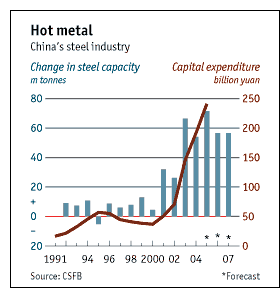 If I remember my Marx correctly (and I did study the stuff for a year in college under Prof. Frederic Bender),
he predicted that the initial host of competitive manufacturers in any industry would be absorbed by a handful of
larger companies, leading to monopoly capital: a few companies big enough to out-price any competition.
If I remember my Marx correctly (and I did study the stuff for a year in college under Prof. Frederic Bender),
he predicted that the initial host of competitive manufacturers in any industry would be absorbed by a handful of
larger companies, leading to monopoly capital: a few companies big enough to out-price any competition.
But he also predicted that as these few giants faced off in the marketplace, the very size and efficiency which led them to dominate creates excess capacity, sparking a price war which eventually leads to catastrophic losses and the collapse of the industry. Marx was wrong in predicting that these cycles would grow in intensity to the point that capitalism itself would collapse, but he was certainly prescient about the dynamics of monopoly capital, excess capacity and massive losses. In a great irony, the largest quasi-Communist nation on the planet is about to receive a brutal lesson on the dangers of over-capacity. Take a look at the chart and note the parabolic rise in money being poured into steel production in China. As Marx predicted, capital (in this case, capital controlled or abetted by the Central Government banks) will flow into growing industries on the expectation that demand will continue rising forever. But alas, as Karl foresaw, once production exceeds demand, then prices fall rapidly. As demand is satisfied by the tremendous increase in production, demand itself starts falling, leading to a downward spiral of price cuts. To stave off the inevitable, production cuts are avoided until the last minute; then, when losses are too great, it's too late; lowering output has little effect. Here is the situation as reported in The Economist: So far this year the mainland has consumed about a third of world output (of 730m tonnes), and its demand is rising at an annual rate of 20% or so. But China's own production is expanding even faster, by around 30% a year. As a result, China, which last year imported about 15m tonnes, is likely to export as much as it imports this year and may have trade surpluses of 9m tonnes in 2006 and 13m in 2007, reckons Trina Chen, an analyst at CSFB.Here then is a classic case of misallocation of capital to an industry that is already producing more than is needed: China in full economic bloom uses 1/3 of total world production (730 million tons) or about 245 million tons. Yet it has invested in plants which can produce twice that amount: 500 million tons. Can the rest of the world, tottering as it is on the edge of recession, find any reason to buy another 250 million tons of steel? The short answer is a morbid chuckle: the rest of the world's steel producers, having grown fat and happy exporting to China, will now be screaming as tens of millions of tons of cheap steel is dumped into their home markets. Marx must be rolling in his grave, for a Communist government is overseeing the greatest misallocation of capital in world history. It is thus poised to bear the terrible consequences: collapse in the price of all industrial commodities like steel, rabid protectionism of those industries in the developed world and worst of all, massive unemployment and financial ruin as the sector sheds the excess capacity. Readers of this modest blog will recall the evidence supporting the view that a recession will begin next year (or perhaps become visible next year, having started last month). Chinese over-production of steel certainly fits into a picture of enormous financial losses caused by the economic malaise of sagging demand. October 12, 2005 Are Japan and Germany Truly on the Mend? 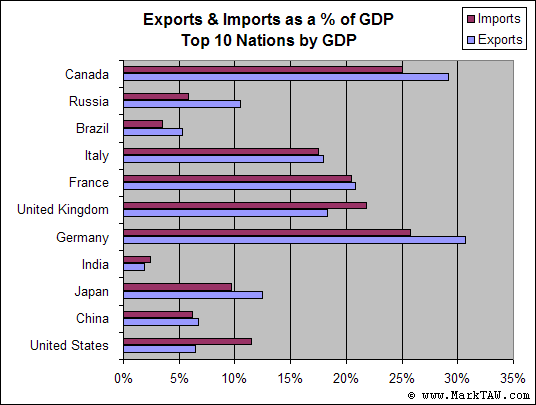
There's been quite a bit in the media recently on the resurgence of Japan and the mending of Germany via a "grand alliance" of its two main political parties. Sounds good, but there's a huge fly in the ointment: those nations' dependence on exports to the U.S. and China to sustain their growth. But first, the good news about Japan emerging from its 15-year "lost decade" of wasted public spending, horrendous public and private debt, and sclerotic political reform process as reported in The Economist: The Sun Also Rises. On a more skeptical note, the Wall Street Journal isn't so sure that Germany has a coherent plan to emerge from its decade-long malaise: New German Coalition Is Unlikely To Tackle Major Economic Change. Meanwhile, the WSJ is glowing with praise for the powerhouse "rust belt" industries centered in Nagoya, Japan: Japan's Economy Gains Steam From Manufacturing Heartland. It's one thing to break out imports and exports, but these numbers don't reflect where the growth is in an economy. Thus, while it appears that imports/exports are a relatively small part of China's economy, this is deceptive: while 80% of the economy is rural/agricultural and government-led, all the explosive growth of assets, profit and wages is occuring in the export business, which is growing by some 30% annually. Recall that up to 40% of China's GDP growth is foreign investment. (See my essay China: An Interim Report for more in-depth reporting on China's economic and environmental challenges.) This reliance on exports for growth is also true of Japan and Germany. What the chart does reveal quite astoundingly is the utter dependence of the European economies on exports--especially Germany. And where are those exports going? Certainly a significant percentage are shipped to other E.U. nations, but the growth is all in shipments to China and the U.S. The same is true of Japan; what the WSJ article fails to explore is precisely the key issue of Japan's so-called resurgence: who's buying all the machine tools, cars and other manufactured goods made in Nagoya? China and the U.S., of course--it certainly isn't their domestic customers or the E.U. To put it plainly: Germany and Japan, the 2nd and 3rd largest economies in the world in terms of GDP, are extremely vulnerable to any slowdown or recession in either the U.S. or China. As a result, all the talk about their resurgence or recovery is misleading to the degree it doesn't reflect their extreme vulnerability to any slackening of demand in the U.S. or China, which would itself stop growing once the U.S. economy tanks. Here's a view of China's own vulnerability. 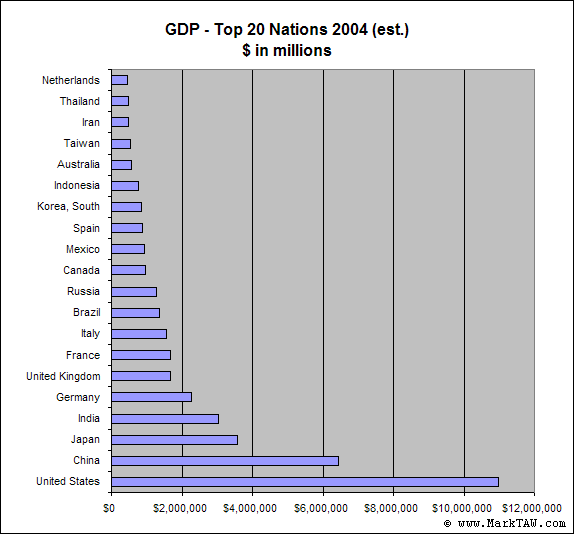
Are we over-emphasizing America's importance here? Just look at the second graph, and note the U.S. dominance as a market for the rest of the world's goods. A 10% slowdown in the U.S. is the equivalent of a good-sized nation (South Korea, Mexico, Spain or Indonesia) vanishing off the face of the Earth. Also note that this graph is based on "purchasing power parity" (PPP) which is what the C.I.A. factbook uses. As measured by dollar activity, Japan and Germany are still larger than either China and India. But the point is obvious: the exporting nations of the world, most especially Germany and Japan, are completely reliant on the robust growth of their biggest markets, the U.S. and China. If either falters, so too will Germany and Japan. If that's resurgence, it's a very precarious one. October 11, 2005 Suzhou River  First, some geography. Suzhou River runs from the city of Suzhou (which I have visited several times) down through Shanghai (which I have also visited several times), where it forms the north border of the city's old commercial hub, the Bund. The opening sequence of the film is a strikingly accurate montage of Shanghai river life: filty water, lined with decaying old buildings in places, and peopled by poor boat and barge operators who live in small quarters on their rivercraft. This is the China not of glossy chic stores but of the gritty realities of industrialization and large-scale poverty. Stylistically, the film employs "new cinema" techniques such as hand-held cameras and saturated reds and greens reminiscient of Wong Kar-Wai's use of color and composition. The movie is categorized, for lack of a better label, as "noir," as the grittiness, sleazy night life and depiction of low-life criminals harkens back to the film noir popular in the 1950s. The core of the movie, however, is a well-used plot gimmick most famously explored by the Hitchcock classic "Vertigo": a question of identity. This is not to say that such derivative plots are bad--it's just that the treatment has to be fresh or we end up feeling that we've seen the film before. On top of this basic plot--is this beautiful young woman the girl who the bike messenger betrayed years before?--is layered another cinematic technique: the POV (point of view), in which the film is narrated by a low-end video producer. Indeed, we never see him, as the camera angle is POV throughout, e.g. we see what he sees, as if his eyes were the camera. The narrator tells his own tale of meeting and falling into a relationship with the gorgeous young woman (Xun Zhou) who performs as a mermaid in a neon-lit bar for a living, and then introduces the story of the motorbike messenger and his doomed relationship with a teenaged girl who has a crush on him. For reasons which are left murky (shall we just call it slapdash?), the messenger gets involved in a kidnap/ransom scheme in which he kidnaps the girl. Once freed, she jumps into the Suzhou River and promptly disappears. At this point, he turns the narration over to Mardar, the messenger, and retreats until the final reel in which he has Mardar beaten up as a rival for the affection of the beautiful young woman. Confused yet? The problem with the film isn't the complicated narrative and POV--it's that we don't believe the characters are real. They are players in a noir fairy tale of sorts, perhaps, but not real people with emotions we can grasp. Indeed, the lead actors and actress are expressionless. Why did Mardar betray the girl who loved him? Did he have no other choice? It seems he had plenty of other options: escape with her, betray the crooks, etc. So having betrayed her, he seeks redemption through finding her again. But then when he apparently does find her, the couple is found dead in the Suzhou River: accident or suicide, we have no clue, but again it seems like a contrivance rather than something integral to the characters. Equally improbably, we're told the beautiful woman leaves the narrator for days on end without explanation, and though this "drives him crazy," he never asks her about it, follows her, etc. The characters are strangely detached from real-life motivations, desires, and emotions. As a result, we are left with a certain dissatisfaction with characters whose internal traits and experiences do not seem consistent or "real." Contrast this with the characters in "Blue," who are at a minimum consistent with what we've been shown, and consistent with emotions and reactions we can understand. Though "Suzhou River" is a visually compelling movie, with first-rate cinematography and technique, a noir assembly does not a character or film make. October 10, 2005 Arab Oil Money and U.S. Treasury Bonds: Quid Pro Quo? 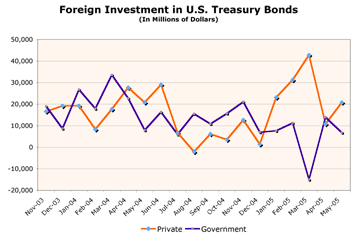 It's been well-documented that foreign central banks, mostly Asian, have been supporting our super-low
interest rates by buying hundreds of billions of dollars of bonds funding our titanic deficit. (For example,
this article from Slate:
"foreign fools who are buying American bonds"
It's been well-documented that foreign central banks, mostly Asian, have been supporting our super-low
interest rates by buying hundreds of billions of dollars of bonds funding our titanic deficit. (For example,
this article from Slate:
"foreign fools who are buying American bonds"
It's also well-known that any faltering of this foreign buying would spell disaster in the form of rapidly rising interest rates: consider this from Yale Global Online: "If Washington fails to rein in the budget deficit, international bond buyers might force a painful adjustment". The risks facing those who hold $1.5 trillion in U.S. bonds are also well-known; here is an article from China Daily admitting that the Chinese government would lose an enormous amount of real money should the dollar decline, for it would immediately depreciate the value of the $470 billion in U.S. bonds they hold: "Crisis looms due to weak dollar". Then there's the specter of the oil-producing nations tiring of their oil wealth being denominated in the sinking dollar; the move from "petrodollars" to "petroeuros" appears to be underway, at least in a modest fashion. The danger to the U.S. is simple: people would need euros to buy oil, not dollars, so they would dump their dollars to get euros. Check out Center for Contemporary Conflict's report: "From Petrodollars to Eurodollars: Are the Dollar's Days as an International Reserve Currency Drawing to an End?" Now we have the possibility that oil-producing nations are stepping into the breach to prop up the dollar and keep U.S. interest rates low: consider this from The Economist magazine: "The $300 Billion Bonanza". The standard line is that oil-producing nations--Norway has a $140 billion pile, but the Arab nations are the predominant winners in the recent oil-price bonanza--buy U.S. Treasury bonds because they're safe. But if U.S. bonds are so "safe," why are the Asian central banks dramatically cutting their purchases? As this chart shows, "private buyers," generally from off-shore Caribbean bank centers, magically stepped in and bought huge sums of Treasuries just as the Asian banks pulled back their buying. Coincidence? Maybe not. Just as speculation: could there be a high-level quid pro quo to the apparent Arab support of the dollar and low U.S. interest rates? This could reflect two quiet policies: Arab support for U.S. pressure on Israel to get on with creating a Palestinian state in the West Bank/Gaza, and also an implicit support for the U.S. occupation of Iraq. Recall that Iraq is 60% Shiite, the Muslim sect which is dominated theologically by Iran. Recall also that the Sunni minority which ran Iraq under Saddam shares religious affiliation with the other Arab nations. (Iran is not an Arab nation; it is Persian.) Could the Arab nations in the Gulf be concerned about the fate of their Sunni brethren should the U.S. pull out of Iraq? Such a concern would be quite natural, geven the rumors that Shiite militias are already operating as "death squads," assassinating Sunnis at will. Put all this together, and you have a motivation for the Arab nations to quietly fill the breach in the gaping U.S. deficit funding left by the retreating Asian Banks. It's something to consider, for if the Chinese are wary of accumulating too many dollars, certainly the savvy sheiks would have the same concerns. October 8 & 9, 2005 "Blue": An interesting film on Love and Loss  To avoid pontificating about what makes a "great film" I am starting a list of "interesting films," which make this modest claim: if you are a serious fan of films, then you will certainly find much of interest in these films. (For a list of movies which have merit in my view, check out reviews.) My initial entry is "Blue" (Bleu), the first film in Krzysztof Kieslowski's Three Colors Trilogy (Blue / White / Red) Unusual in film of any era, Kieslowski also uses sound as a thematic transition, invoking the main character's memories not as visual images of her dead husband and daughter but as minor-chord representations of her loss. (Her husband was a famous composer, and she's no slouch at writing a score, either.) At these junctures, the soundtrack of ambient noise--her splashing around a pool, for instance--is suddenly overwhelmed with powerful orchestral music in a minor key. As the sound swells the screen goes black, as if her visual sense has been similarly overwhelmed by memories of the people and life she has lost. While the death of my own sister in a car crash of the same sort that kills Julie's (Juliette Binoche) family no doubt adds to the film's personal meaning, I think its depiction of the loss resulting from the death of loved ones is universal. In the film, Julie tries to evade her grief by denying all connections to people or things: she abandons her gloriously medieval stone home and everything inside it except one kitschy lamp, and refuses contact with neighbors, family and most intimately, with a man who confesses he has secretly loved her for years. We can all grasp the emotional appeal of cutting off memories, relationships and meanings; in the depths of her profound alienation from life, Julie's character states that "nothing is important." But as the movie unfolds, we see through Julie that such emotional distance is impossible to maintain; Julie forms bonds with a call-girl in her building, and with a mouse whose presence frightens her in a child-like way. The themes of loss are multiple; Julie's mother suffers from dementia, reflecting the loss of meaning and memory. She discovers that her husband had a secret mistress, who is now pregnant with the dead man's child--a painful irony to Julie which heightens the loss of her own child and piles yet another loss on her: the destruction of her husband's fidelity to her in life. Julie also rejects music and the creative energy of life, refusing to help her husband's colleague (the man who has secretly loved her for many years) finish the important score her husband was working on at his death. This denial of public self, of ambition, of talent and of art is part and parcel of her rejection of all ties to life; she destroys what she believes is the only copy of her husband's unfinished masterpiece. But when a copy of the work turns up in the colleague's hands, he attempts to finish it more as a recognition of its importance than as an expansion of his admittedly weak talents. Somehow she cannot let the work be completed in a mediocre fashion, and so she begins writing the ending as she knew her husband had intended it. Her renewal finds full voice when the colleague/lover insists that she take public credit for the work. With the musical bond between them established, she gives in to the love he offers her. There are quibbles, of course, as there is with any art; it is certainly easier to overcome grief when you have enough money for a splendid top-floor flat in Paris, and a talented, handsome character is madly in love with you. The connection between a street flautist and her replacing the trumpet with a flute in the final score is perhaps too artful; but many other scenes are anachronistic and unforced, much like life itself. The dialogue is sparse, naturalistic, telling; Binoche does a wonderful job evoking a spirit-shattering grief. There is mystery in the film--some of which is illuminated later in the film, some of which is left as detritus from chance encounters--but whatever is not explained is thematically related as opposed to art-house contrived. To explain the difference, I'll look at another interesting but not quite as moving film next: Suzhou River A great film stays with you, not just as a series of striking visual images, but as a satisfying unfolding of characters and situations which feel emotionally real. The cliche in Hollywood circles is "I'm good with story," and this explains why most Hollywood films are forgettable: story is "rien" (nothing), character is everything, and you cannot plot out a character in the same cookie-cutter fashion as you can a story line. In a great film, the characters come across as whole beings, while in mediocre movies they are nothing but pieces assembled without any deeper understanding of the character by the screenwriter. In mediocre films, we are left not with the sense of an authentic person but with annoying holes and disconnects--all the nagging parts which simply don't fit together in a person's behavior, motivation, crisis and response. "Blue" exemplifies this authenticity of character, and this is why it's a great film. Oops, I mean an interesting film. October 7, 2005 The Problem with Techno-Fixes Here's the solution to all our problems: a new technology. There's only one catch: humans are still part of the equation. Let's take hybrid auto technology for an example. It's a darn good idea, storing energy from braking the car to be used later, and using an electric power drive when loads are undemanding. So far so good--but then why do hybrids advertised as getting 60 MPG (miles per gallon) actually get 30 MPG? Because the driving is still performed by humans. Consider this from the Wall Street Journal of Oct. 6, 2005: "At Toyota, luxury brand Lexus has begun distributing through dealerships a pamphlet on the RX 400h, Lexus's luxury hybrid SUV, listing reasons why the vehicle may not get the 31 mpg the EPA estimated for the vehicle in city driving. The EPA tests, the brochure points out, assume drivers accelerate slowly, leave the air conditioning off, and average a speed of 20 miles per hour in the city. The pamphlet tells drivers that quick acceleration, heavy braking and driving at speeds above 60 miles per hour can make the mileage lower than the EPA estimates.So in other words, if you constantly stomp on the accelerator and brakes, drive 85 miles per hour down I-5, never bother checking your tire pressure, then your mileage will be as lousy in a hybrid as it is in a standard car. Using common sense that's been around for decades (don't drag race at every green light, keep tire pressure balanced and at the recommended level, don't go 80 mph when 70 will get you there just fine, etc.) I consistently get almost 40 MPG in my standard Honda Civic (highway driving) and over 30 MPG in the city. Is hybrid technology the magic bullet which is going to turn our society into a energy-conserving paradise? Unfortunately, the answer is no if a standard economy car like the Civic beats the daylights out of a $50,000 hybrid SUV. Note the Lexus gets 31 MPG if driven perfectly, so in reality it gets 20-25 MPG--the average for the entire gas-hog U.S. auto fleet. So manuacturing hybrid vehicles which in actual use get about 2/3 the MPG of my 1998 Civic is going to solve our energy problem? If only it were that easy. October 6, 2005 A Sobering Clipping File Herewith are clippings which relate to recent posts on the unprecedented risks facing the U.S. stock market and economy: 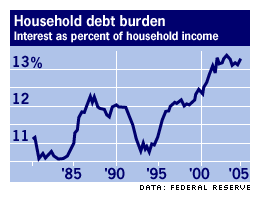 Reuters: "The credit derivatives market grew by almost 48 percent in the first six months of the year to
$12.4 trillion, the International Swaps & Derivatives Association (ISDA) said on Wednesday."
Reuters: "The credit derivatives market grew by almost 48 percent in the first six months of the year to
$12.4 trillion, the International Swaps & Derivatives Association (ISDA) said on Wednesday."
Just in from the Fed: non-mortgage household interest at new highs
Marc Faber: "The Bureau of Labor Statistics has calculated that health care inflation in the last ten years or so averaged about 4% per annum. However, from private studies we know that health care costs have risen by around 10% per annum in the last few years. Moreover, whereas the weighting of the BLS's health care expenditures within the CPI is only 6%, health care represents about 17% of consumption." Richard Daughty: (Mogambo Guru Economic newsletter) As a kind of interesting coincidence to this prediction (a Dow low of 8450 by December 1, 2005) is the appearance of the Hindenburg Signal, which is a signal based upon the number of new stock highs and new lows as a percent of total volume that was developed by Kennedy Gammage. The Hindenburg Signal predicts that a stock market crash has become likely within the next 30 days. Not only that, but the McClellan Oscillator is negative. Somebody, I forget who, noted that the latest University of Michigan Consumer Sentiment also produced a stock market crash signal, in that it had a one-month fall that was the biggest drop in fifteen years or something." 10/5/05 CBS Marketwatch column on the Hindenburg Signal Wall Street Journal, October 5: "Asian Bull Markets Face Twin Red Flags Energy Prices, Rising Rates, Could Curtail the Rallies; Local Investors in the Mix" 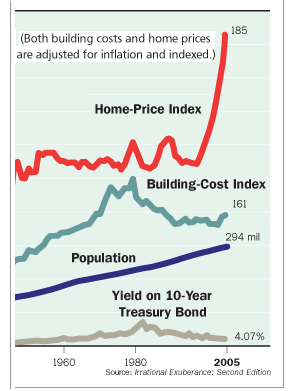 "But the gains have come as energy prices have jumped, threatening to spark inflation -- and leading many
observers to question whether the major Asian equity markets are accurately reflecting the underlying health
of the region's economies."
"But the gains have come as energy prices have jumped, threatening to spark inflation -- and leading many
observers to question whether the major Asian equity markets are accurately reflecting the underlying health
of the region's economies."
An unprecedented housing bubble
as housing price index skyrockets Yahoo News: "The Interior Department said Tuesday that heavy damage by Hurricanes Katrina and Rita would mean a slow recovery for offshore natural gas production. The Gulf Coast produces about one-fifth of the product used by U.S. industry and to heat homes. The loss of output is particularly troublesome, analysts say, because there is no emergency stockpile. Natural gas futures, which closed at a record high $14.224 per 1,000 cubic feet on Tuesday, jumped an additional 39.6 cents to $14.62. 'The outlook for winter is grim, and the threat to the U.S. economy is real from extremely high gas prices and shortages,' Energyintel analyst Tom Wallin said in a research note." Is this the snapshot of a healthy economy? I think not. October 5, 2005 Demographics and National Bankruptcy 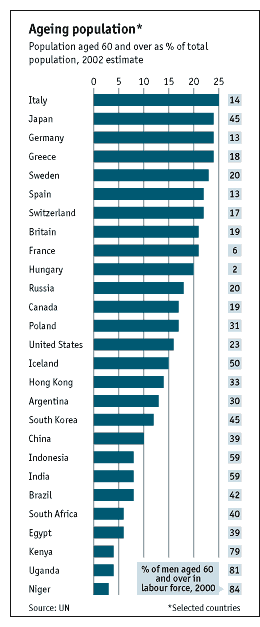 The cliche is that demographics is destiny. When it comes to bankrupting a nation, it's certainly true.
The problem facing all nations with any sort of social security or government entitlement for elderly citizens
is graphically demonstrated by the accompanying chart. The bar graphs denote what percentage of the citizenry is
over 60--retirement age in the developed world--and the numbers along the right-hand border convey what percentage of the male
population is still working after the age of 60.
The cliche is that demographics is destiny. When it comes to bankrupting a nation, it's certainly true.
The problem facing all nations with any sort of social security or government entitlement for elderly citizens
is graphically demonstrated by the accompanying chart. The bar graphs denote what percentage of the citizenry is
over 60--retirement age in the developed world--and the numbers along the right-hand border convey what percentage of the male
population is still working after the age of 60.
It's easy to see the shape of the demographic time-bomb awaiting the European Union nations. In Italy, to take only the most egregious example, fully 25% of the population is over 60, while only 14% of the men over 60 are still working, and therefore contributing to the national social security costs via taxes. The story gets even worse in France, where a mere 6% of the male population over 60 is still in the workforce. Contrast this with poorer nations such as Indonesia and India, where 60% of the men over 60 are still working. The reason is fairly obvious: these nations do not provide generous retirement benefits to their over-60 citizens. In the Western countries, the question is: why work in your 60s when you can draw a nice pension for not working? The incentives are out of date, and now the Western nations face bankruptcy within our generation. Back in the day, people retired at 60 because they were broken by hard physical labor; many died before reaching retirement age. Now the average lifespan is nearly 80 throughout the developed world, so retirees are drawing pensions not for a few years but for two decades. Note that not all developed nations have such generous (or shall we say fiscally unsound) policies: men in Asian nations are still working after reaching 60: 45% in both Japan and South Korea. Obviously, that stronger work ethic will take significant pressure off those nation's social security systems.  The solution to the impending bankruptcy of Social Security and Medicare is fairly obvious: raise the age at which you can begin drawing benefits to 70. The programs will still take care of citizens as they age, but they will reflect the realities of demographics: many more people are living far longer than when these entitlement programs were designed in the 1930s and 1960s. It's time to bring the programs into line with reality. Since the greediness of the current generation knows no bounds, the cuts will have to fall on the Baby Boomers (myself included). The sooner the better, for the good of the nation and the generations behind us. I just read a work on global demographics which I recommend: Fewer: How the New Demography of Depopulation Will Shape Our Future Read the book. Demographics is destiny. October 4, 2005 October Crash Redux One reader reports that every time she reads one of my financial entries, she gets an urge to jump out the window. Yes, I know I write about evidence for a doom-and-gloom outcome to this era's bogus "prosperity," but I am not the only one. In general, the press is rather more skeptical of a bright prognosis for the U.S. economy than the financial industry--the big brokerage houses--who are of course eternally optimistic. It's always a good time to buy stocks of some sort, or better yet, cash out of one sector and move the money into another, and thus generate two commissions instead of one. 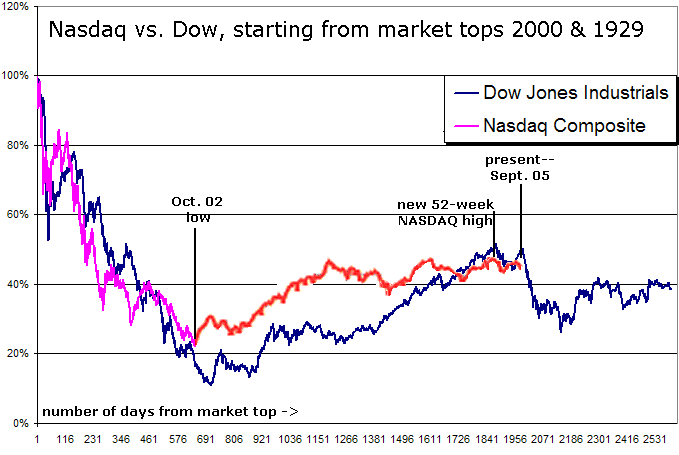 Compare the bullish bias of Smith Barney's top U.S. equities analyst, Tobias Levkovich, with Barrons
magazine's run of skepticism. While hardly a bastion of anti-capitalist fervor, Barrons' columnists and
technical analyst are bluntly wary of U.S. stocks and the prospects for the usual fourth quarter run-up.
Compare the bullish bias of Smith Barney's top U.S. equities analyst, Tobias Levkovich, with Barrons
magazine's run of skepticism. While hardly a bastion of anti-capitalist fervor, Barrons' columnists and
technical analyst are bluntly wary of U.S. stocks and the prospects for the usual fourth quarter run-up.
Nobody is predicting an October crash similar to the one which caught everyone by surprise in 1987, so allow me the honor. Let's compare some very basic factors which underpin a bullish market heading for the stars. Levkovich is aware that he has to come up with some huge sources of cash in order to support his bullish claim, and so he stretches out, way out, to dig up some arcane measures of liquidity to show us that there is money around, but unfortunately we can't see it directly--it's in hedge funds and foreign hands. But instead of trusting his fancy-footwork, let's look at sources of cash we can measure reliably: the amount of cash sitting in mutual funds, and the amount of borrowing power sitting in stockholder's margin accounts. (Margin is a loan which brokerages extend based on the value of your portfolio.) According to Barrons, mutual funds are holding a mere 3.9% of cash, far lower than the 8-10% which they've held prior to market runs. Margin debt is currently an enormous $208 billion, compared to only $83 billion ten years ago before the great bull run began in earnest. 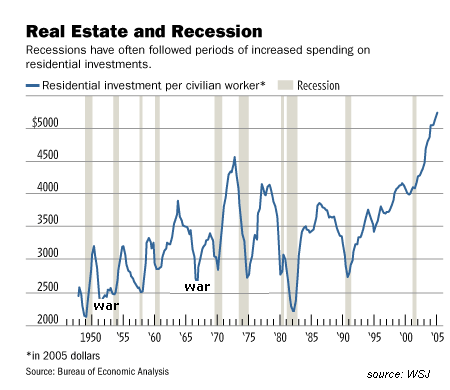
Even more damning, the source of cash Levkovich is counting on to fuel his 15-month bull market is classic "hot money"--money that spins in and out of "investments" with lightning speed. That's hardly the basis for a sustainable bull market. But again, let's look at more trustworthy numbers. According to Barrons, Investors Intelligence Poll of Bulls/Bears is currently 53.2%/26.6%, compared to a ratio of 31%/50.9% ten years ago. Note that the numbers are exactly reversed: before the great bull run of 1995, 50% of investors were bearish--the perfect contrarian setup. Now investors are 53% bullish, a perfect bearish setup--yet Levkovich sees only blue skies and another 15 months of bullish upside. Are we touching the elephant's trunk while he feels the tail? It would seem so. So allow me to posit the unthinkable: the markets are poised not for a 15-month run up to new and giddy heights, but for a sudden, sharp drop of 10% to 20% this month. There, I said it. Let's see if thunder rumbles and lightning strikes. October 3, 2005 The Nelson Touch: Trafalgar at 200  Though that supremacy has shifted to the U.S., the English Admiral continues to command affection and admiration around the world. Why? Although there are many fine biographies of Nelson, I recommend a lesser-known work: For God and Glory: Lord Nelson and His Way of War The book provides a number of key points about Nelson as a human being and as a military leader. So consider celebrating Trafalgar's 200th anniversary by reading more about a fascinating personality and genius-- even if his genius was war at sea. October 1, 2005 Read This Book  Running On Empty: How The Democratic and Republican Parties Are Bankrupting Our Future and What Americans Can Do About It The author makes it clear it wasn't always like this; the Founding Fathers and plenty of subsequent leaders were rock-solid on the dangers of accumulating enormous public debt. Yet now we have Vice President Dick Cheney stating that "Reagan proved deficits don't matter." Read this book and then try to agree with Mr. Cheney. You can't. How much will the Federal government have to come up with, via taxes or borrowing or both, to pay for the retirement benefits and Medicare for the 77 million Baby Boomers who start retiring in 2008? Try $27 trillion--or $43 trillion. The numbers vary depending on who's doing the estimating, but the bottom line is obvious--the sum is more money than the nation could ever hope to raise. The entire Federal government consumes about $1.4 trillion annually at the moment, of which $400 billion is borrowed from the Chinese and Japanese central banks (and a few other foreign central banks). Do you have any idea how much interest we collectively pay on the $8 trillion in Federal debt we already have? $335 billion, and it goes up every year. Check the official U.S. Treasury website and see for yourself. And since we're borrowing $400 billion more every year, we're insuring that the interest expense will go up every year. And this is with interest rates at their lowest level in a generation. If that doesn't frighten you, you're in absolute denial. We are paying almost as much in interest as we are for the entire U.S. Military, and if interest rates shoot up--well, then the interest expense will be greater than the cost of the Armed Forces. That's an astonishingly large and permanent burden on future taxpayers. The author forces you to accept these numbers, for everyone who's ever looked at it, from the GAO to blue-ribbon panels from both parties, reaches the same conclusions. Certainly the current generation of retirees is the greediest on record, happily scarfing up huge benefits of which they paid only a fraction of the cost during their working years; so as I have noted here before, Boomers: Prepare to Fall on Your Swords, the Baby Boomers will have to accept benefits much more constrained than those their freeloading parents raked in. (Estimates suggest cutting benefits by half might just save the system from complete collapse--if we raise taxes enough to eliminate the deficit immediately.) But as the author notes, the Republicans are in the grip of a theology of tax cuts, and they really don't care about deficits because fiscal reality is not part of their religion. The Democrats, meanwhile, have never seen a social entitlement program they didn't want to increase, even if 80% of the recipients are doing just fine without the government handout (for instance, the new Medicare drug plan give-away). The road to ruin is paved with profligate public borrowing and entitlement spending without limits. Reality has a way of interceding on fantasy, so mark the years 2006-2015 as the decade the chickens come home to roost. The best we can hope for now is a quick collapse of the dollar and an end to foreign financing of our mad borrowing. As long as the Asian central banks continue to pour the drinks, then the debt addicts currently leading our nation will happily slosh another $400 billion or $500 billion a year onto future generatiions. But read the book and come to your own conclusions. wessay noun, combination of 'web' and 'essay,' denoting a short essay which exploits the hyperlinks, interfaces and interactive capabilities of the World Wide Web; coined by Charles Hugh Smith on May 1, 2005, in Berkeley California. copyright © 2005 Charles Hugh Smith. All rights reserved in all media. |
||
|
|
home |